The food you eat may be growing in stuff that you once flushed down the toilet. At the O’ Fallon, Missouri wastewater plant (2 MB PDF) 350 tons of Class A fertilizer–the Environmental Protection Agency's (EPA) top rating–is produced on average each month. Known as biosolids, the fertilizer is derived from human and other organic waste. Farmers use it to grow crops; we buy and eat the produce. We have come full cycle.
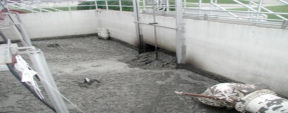
Biosolids are like vitamin pills for soils, according to Ken Arnold, Chief of Land Application with the Missouri Department of Natural Resources. “There are no fertilizers available on the market today that can supply a more complex array of essential trace nutrients,” he adds, citing metals such as molybedenum, vanadium, zinc and iron. “A fertilizer blend composed of all the required plant nutrients would be costly — beyond the financial means of an average farmer.”
In 2004, 718,000 dry tons of biosolids were used as fertlizer in the U.S., 85,000 dry tons just in Missouri, according to the EPA.
There is a long history of applying human waste as fertilizer. As early as 1865, entrepeneurs were contracting to remove “night soil” (biosolids) from New York City outhouses and ship it to farmers for their fields, according to records in the New York Times archives. The main difference between then and now is how the biosolids are pretreated to remove living organisms to provide safer fertilizers, say experts.
Wastewater biosolids go through several processes to eliminate pathogens, states Dan Scherer, Managing Director of Water & Sewer Operations for the City of O'Fallon. “[Our biosolid] product is registered as an acceptable fertilizer with the State of Missouri.”
To get those biosolids, the O’Fallon plant processes between 8.5–9 million gallons of water per day. Time of day determines the type of water that enters the system. Half of the flow during the day is from industry and at night it is all from homes.
The plant uses no added chemicals in the purification process, according to Richard Stephan, Plant Supervisor and Pretreatment Coordinator. Instead, the plant relies on gravity, density and microorganisms to extract the biosolids from wastewater.
The first step uses ¼-inch screens and gravity to remove unwanted materials like cigarette butts and plastics from the wastewater. The water is then pumped into the center of a tank, known as the primary clarifier. Here, air is pumped in from the bottom to aid in settling out the solids, which are used in the fertilizer. Floating materials, such as lettuce leaves and corn fiber, are skimmed off the top. This is by far the smelliest phase of the process.
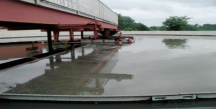
The liquidy biosolids then enter a holding area where they are mixed with returned activated biosolids and sprayed up into towers. Two seconds later, the biosolids have “roller coasted” to the tower's bottom. During those two seconds bacteria in the biosolids, along with other microbes living on plastic grids in the tower, absorb and digest much of the biological matter. These bacteria actually come into the plant with the wastewater. In addition, this plant keeps “bugs” in storage to deal with shortages that might occur when something in the water kills the microbes.
These bacteria are key to the success of the plant. Air is pumped in to keep the bugs healthy for their short day in the towers. “Young” bacteria work more efficiently, so the plant “wastes out between 5000–6000 pounds of bugs per day,” says Stephans. To get the most efficient work from the bugs, the plant operators measure a parameter called the biological oxygen demand (BOD). Too much air is detrimental to the bacteria; too little and they die.
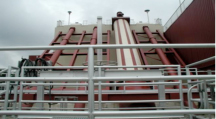
Four 15–foot deep aeration tanks are the next home for the liquid biosolids and their resident “bugs”. The black bubbly surface gyrates and pulses, like the blob from the black lagoon, due to the 19 air jets on the bottom of each tank. Stephens tells SciJourner that these tanks also serve as a storage and production area for the bacteria. They store about 17000 pounds of microbes to be used in the biotowers if needed.
This phase is the most critical part of process. Stephans has workers check the BOD three to four times per day. They use air flow and water input to carefully control the oxygen concentration.
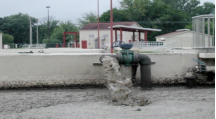
The last tank has two jobs. First, it filters out the treated biosolids, leaving behind clear water that flows out over the tank's top. This water passes under ultraviolet lights to kill any remaining organics before being pumped into the Mississippi River. Second, treated biosolids remaining in the bottom of the tank either go to the digester or are put back into the system.
Scherer states that the bugs in this tank last about one day before they are sent to the digester. Aged, unusable bacteria also end up in the digester. According to Stephans, the bugs turn into cannibals and “eat” each other.

What is now a liquid sludge in the digester travels to the biosolids plant where it is pressed to remove water, and heated to 160 °C for 30 minutes to destroy any remaining pathogens. Lime is mixed in to raise the pH. This final product is stored for 24 hours to ensure that the pH remains above 12, which indicates that all the pathogens are dead. The resulting fertilzer product is 35% solid, and the farmers use a manure spreader to desposit it on fields. Trish Baker
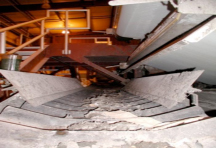
Further Reading
Study Shows Intersex Fish in Missouri River
Bacteria Create aquatic superbugs in waste treatment plants
Public water supply district No.2
City of O'Fallon /Water-Sewer web site
St. Charles County Missouri Master Plan: Envision 2020
USDA Agricultural Research Service
Microbiology. Detection of 140 clinically relevant antibiotic resistance genes
EPA: Proposed Wet Weather Policy to Improve Wastewater Treatment
U.S. Environmental Protection Agency Combined Sewer Overflows
DHS(Down-flow Hanging Sponge) bio-Tower a Sustainable Method for Waste Water Treatment

This work is licensed under a Creative Commons Attribution-NonCommercial-NoDerivs 3.0 Unported License




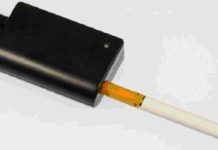


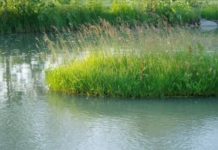






Human waste as fertilizer? Hmmm….interesting. 🙂 great article